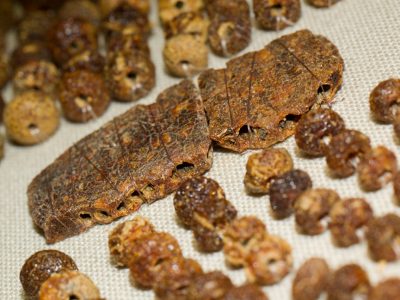What the heck is a lek?
Males great bustards perform spectacular courtship displays, gathering at a ‘lek’ or small display ground to try to impress the females.

Home » Collections showcase » Amber necklace
The necklace was found with the cremated remains of a woman buried at Upton Lovell, near Stonehenge. She was laid to rest in a Bronze Age barrow in about 1,800 BC. Close by was another cremated burial, perhaps a member of her family.
But who was she? No-one knows for sure – but she must have been important for so many precious items to have been included in her burial.
The necklace was made of around 1,000 amber beads, but now just over 300 survive. Imagine the vibrant orange and amber tones catching the light!
The beads are strung in nine rows, each row held by a rectangular spacer plate.
The necklace has been examined in detail, but the clues to its origin remain a mystery.
Flat ‘spacer-plates’ were drilled to hold the six strings of beads in place.
Necklaces made using flat spacer-plates have been found in female burials across Europe, ranging from Orkney to Mycenaean Greece. Many are made of amber, which comes from the shores of the Baltic, and it is likely that they were made there.
But there are also examples of similar ‘spacer-plate’ necklaces made from Whitby jet, found on the Yorkshire coast. This could suggest that this style of necklace was also made in Britain, using local materials.
Some also believe that the beads might be from two separate necklaces.
The story of the beautiful amber necklace is full of mystery, firing the imagination. In the video below, student Amy Ellis (15) outlines how the necklace could provide perfect inspiration for a Key Stage 3 English creative writing project.

Also found in the grave were these precious items:
Gold drum-shaped beads – these eleven beads may have been part of a necklace or were possibly sewn onto clothing as decoration. They were made from coiled strips of gold with a gold cap at each end.
Gold caps – may have once decorated the ends of wooden staffs or sceptres.
A cone-shaped shale pendant, with a gold cover decorated with incised lines.
| Cookie | Duration | Description |
|---|---|---|
| cookielawinfo-checkbox-analytics | 11 months | This cookie is set by GDPR Cookie Consent plugin. The cookie is used to store the user consent for the cookies in the category "Analytics". |
| cookielawinfo-checkbox-functional | 11 months | The cookie is set by GDPR cookie consent to record the user consent for the cookies in the category "Functional". |
| cookielawinfo-checkbox-necessary | 11 months | This cookie is set by GDPR Cookie Consent plugin. The cookies is used to store the user consent for the cookies in the category "Necessary". |
| cookielawinfo-checkbox-others | 11 months | This cookie is set by GDPR Cookie Consent plugin. The cookie is used to store the user consent for the cookies in the category "Other. |
| cookielawinfo-checkbox-performance | 11 months | This cookie is set by GDPR Cookie Consent plugin. The cookie is used to store the user consent for the cookies in the category "Performance". |
| viewed_cookie_policy | 11 months | The cookie is set by the GDPR Cookie Consent plugin and is used to store whether or not user has consented to the use of cookies. It does not store any personal data. |

Males great bustards perform spectacular courtship displays, gathering at a ‘lek’ or small display ground to try to impress the females.
The great bustard has a dignified slow walk but tends to run when disturbed, rather than fly.
The hen-bird on display at The Salisbury Museum was one of the last great bustards to be eaten in the town!